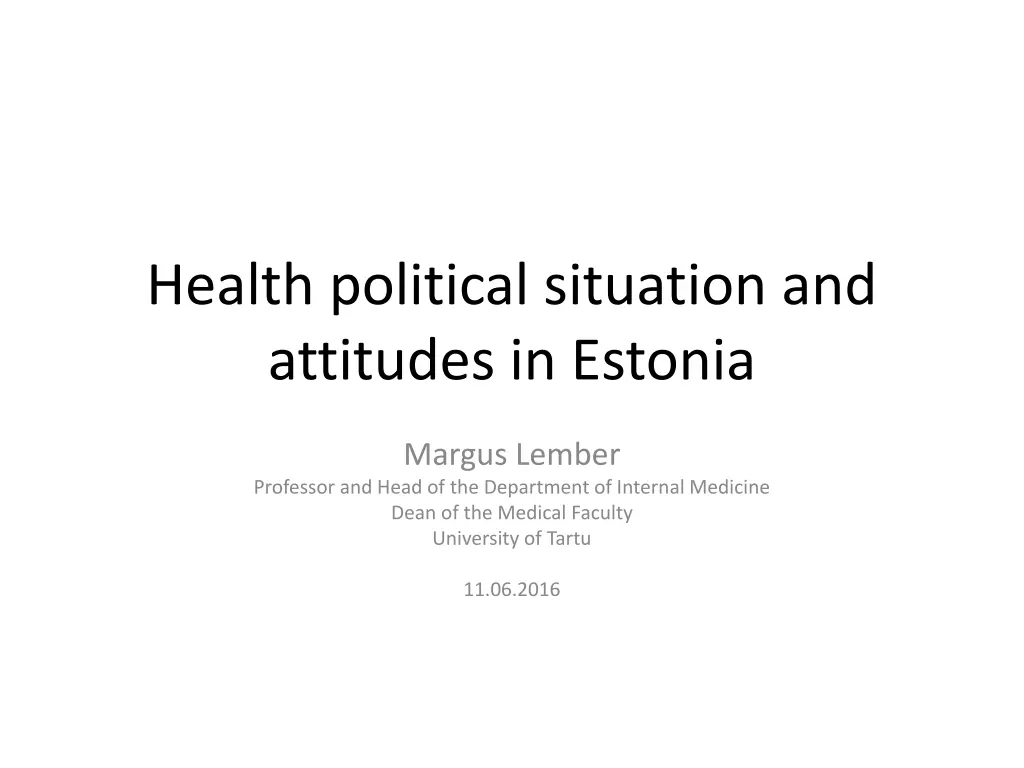
Healthcare and Academic Excellence in Estonia - Insights by Margus Lember
Discover the healthcare system and academic achievements in Estonia through the perspective of Margus Lember, a prominent figure in the field of internal medicine. Learn about the University of Tartu's rich history, Faculty of Medicine, research achievements, and the organization of healthcare in Estonia. Gain insights into the country's compulsory public insurance system and its coverage. Explore the milestones in establishing the University of Tartu and its significant contributions to medical education and research since 1632.
Download Presentation

Please find below an Image/Link to download the presentation.
The content on the website is provided AS IS for your information and personal use only. It may not be sold, licensed, or shared on other websites without obtaining consent from the author. If you encounter any issues during the download, it is possible that the publisher has removed the file from their server.
You are allowed to download the files provided on this website for personal or commercial use, subject to the condition that they are used lawfully. All files are the property of their respective owners.
The content on the website is provided AS IS for your information and personal use only. It may not be sold, licensed, or shared on other websites without obtaining consent from the author.
E N D
Presentation Transcript
Health political situation and attitudes in Estonia Margus Lember Professor and Head of the Department of Internal Medicine Dean of the Medical Faculty University of Tartu 11.06.2016
Milestones in History 1632: founded by Swedish King Gustavus II Adolphus 1802: reopened by Russian Tsar Alexander I as Imperial University at Tartu 1919: reorganized and reopened as the University of Tartu of the Republic of Estonia 3
Biomeedikum- most of the preclinical studies, preclinical and translational research Tartu likooli Kliinikum clinical studies, clinical research
Faculty of Medicine A single medical school in Estonia since 1632 1900 students (incl 100 international students): 233 bachelor s studies; 1208 bachelor s and master s integrated studies 224 Master s studies; 230 Doctoral studies; 540 residents (postgraduate medical training)
Academic structure: institutes 1. Biomedicine and Translational Medicine 2. Family Medicine and Public Health 3. Pharmacy 4. Clinical Medicine 5. Dentistry 6. Sport Sciences and Physiotherapy
Medical Faculty 595 staff members : 260 teaching staff (42 professors); 119 research staff 216 non-academic staff
Research production International peer-reviewed papers: 2013 299 2014 336 2015 313 PhD dissertations: 15-20 per year
Organisation of health care in Estonia Compulsory public insurance 95% of population is covered Special tax (33% of the paid salaries, employer`s responsibility) 13% for health care, 20% for pensions Covers: health services, compensation for sick- leaves, compensation for medicines
HIF contracts with hospitals and primary care providers (independently contracted FPs) Hospitals: contracts (service volume and funding ceilings), fee-for-service combined with DRG Primary care: capitation, lab and investigation fund, quality bonus, some bonus on location of practice
Estonian health care reforms in 1990s- the most successful among all Eastern European countries: Health insurance fund Family medicine in primary care Decreasing of hospital bed capacity Emergency medicine reforms Use of technology E-solutions The most cost-effective health system
Number of doctor consultations per person, 2013 (or nearest year), OECD 2015
Challenges in health care 2016 Limited funding Limited health care personnel Hospital network not adjusted for population needs and service providers`needs Changes in demographic structure
The 2015 Ageing Report: Economic and budgetary projections for the 28 EU Member States (2013-2060) European Commission
Towards future Increase funding- political will and agreement in society is needed. Are social welfare state models possible in future? Depending on economy of a country
Health care providers Wize solutions in an optimized system Among others e-solutions and genes
e-solutions and genes Additional costs ? or Benefit ?
Genomic poject Research or health care? How far we are? Different viewpoints Who should fund? Whose benefit?
Some concerns expressed by the Medical Faculty (2013) Does knowing of the genetical risk of an individual influence the health behavior in a way that impacts to the chronic disease morbidity in society? Do the costs of genetic testing pay back in lower morbidity, lower health care costs for the society?
How much does genetic testing add to the real prevention of chronic diseases? Transferability of the results of genetic testing on a population level to individual risk assessment Phenotype- genotype relationships Validity of using genetic markers in clinical practice
Interpretation and clinical meaning of the results of genetic testing- do we know enough? Should society pay for this?
How to use the results? This is a great challenge in health care. This is not an issue of performing additional analyses . Research is needed what to do, how to do, what not to do!
